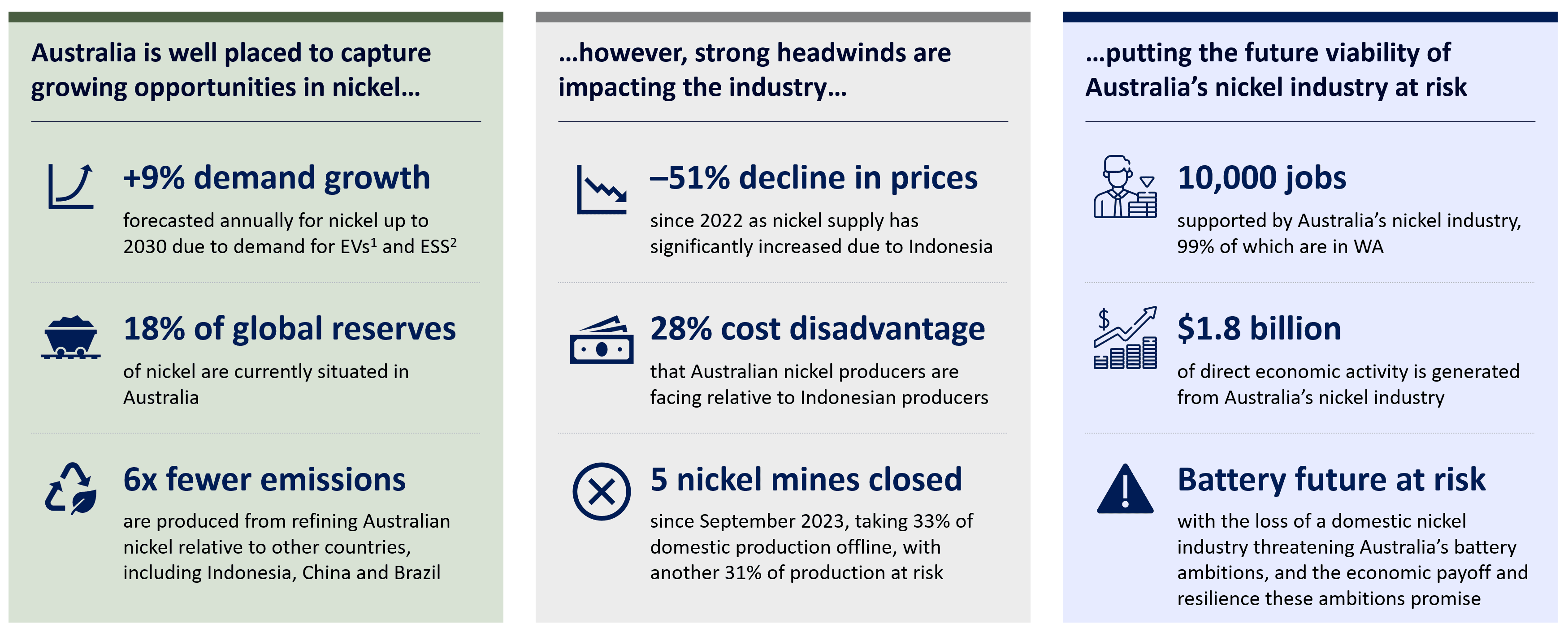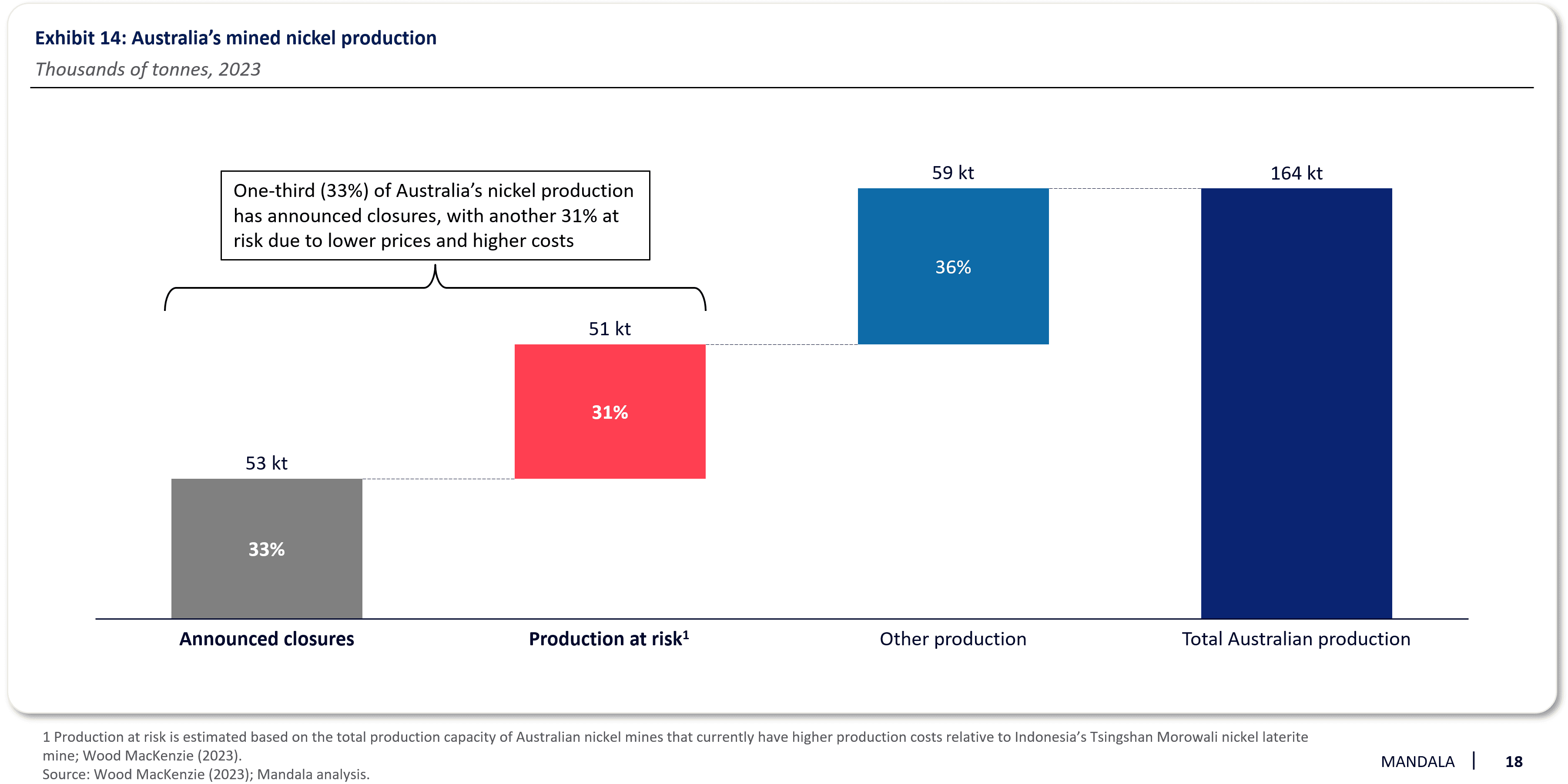
Australia's opportunities and challenges in Nickel
08.02.2024 - 12:59
Our new report ‘A Critical Juncture’, commissioned by the Chamber of Minerals and Energy of Western Australia, explores Australia's opportunities and challenges in nickel. Our report finds we have inherent advantages as Australia is well placed to capture growing opportunities in nickel with a 9% annual growth forecast. Australia holds 18% of global reserves, which we can refine with significantly less emissions than our competitors. However, growing supply from cheaper Indonesian nickel producers that are more cost-competitive has led to lower prices, which has already seen the closure of a third of Australia’s nickel production. This puts approximately 10,000 jobs, $1.8 billion of economic activity, and Australia’s future battery industry at risk.
Australian nickel has significant opportunities, however strong headwinds are placing its future viability at risk.

The energy transition offers significant opportunities for Western Australia’s resources industry and minerals exports such as nickel.
As the world accelerates efforts aimed at electrification and moves away from fossil fuels, Western Australia and Australia will need to capture growing opportunities in battery minerals, such as nickel, lithium, and cobalt. Battery demand is expected to increase by 24 per cent annually over the coming decade, driving the need for battery minerals.
Australia, and Western Australia in particular, is positioned to play an important role in the global battery value chain. Australia holds 18 per cent of global nickel reserves while also having (1) strong ESG practices and (2) global policy tailwinds.

However, the Australian nickel industry is facing strong headwinds, and its future viability is at risk.
Recent drops in nickel price (down 51 per cent since 2022) and growing cost pressures in Australia have led to five Western Australian nickel producers, constituting a third of annual domestic production, announcing closures, with many other producers at risk.

The nickel industry is strategically vital in supporting Australia’s sovereign capability, economic resilience, and resource security. The decline of the nickel industry puts at risk nearly 10,000 jobs, $1.8 billion of economic activity, and Australia’s future battery industry.
Download the full report here.
Read our latest posts

The Value of Online Payments to New Zealand Businesses
Mandala partnered with Stripe on a research report based on the findings of a survey of 200 New Zealand businesses around the value of online payments and opportunities for future innovation.
18 Dec, 2025

Optimising Australia’s Specialist Investment Vehicles for the Net Zero Journey
Mandala, in partnership with IGCC, explores how Australia’s Specialist Investment Vehicles (SIVs) are deploying public capital to accelerate the net zero transition. The report examines the current funding landscape, identifies structural challenges that limit the effectiveness of public investment, and sets out a pathway to evolve the SIV system into a more coordinated, capital-led model aligned with national priorities.
10 Dec, 2025

$160 billion and counting: The cost of Commonwealth regulatory complexity
Our latest research for the Australian Institute of Company Directors (AICD) reveals Australia’s growing regulatory burden. The cost to businesses of complying with federal regulation has risen to $160 billion (5.8 per cent of GDP), up from $65 billion (4.2 per cent of GDP) in 2013. More complex laws are contributing to the increase in costs and redirecting business resources away from growth and innovation. Board time on compliance has doubled from 24 percent to 55 percent in 10 years, while the external legal spend now sits at $16bn up from $6bn in 2010. While the UK, EU, Canada, New Zealand and US are simplifying regulation to drive growth, Australia risks falling further behind without taking immediate policy action.
2 Dec, 2025

Data Centres as Enabling Infrastructure
Mandala’s latest research, commissioned for Data Centres Australia by AirTrunk, Amazon Web Services, CDC Data Centres and NEXTDC, shows that data centres are key drivers of economic growth, renewable energy investment, and sustainable water solutions. The report finds that data centres use relatively modest amounts of energy and water while generating significant economic value, investing in power and water infrastructure that benefits communities, and helping to accelerate Australia’s clean energy transition.
25 Nov, 2025